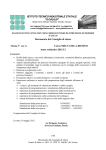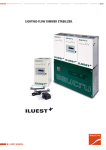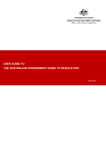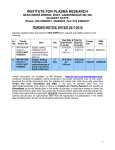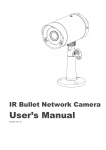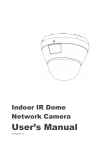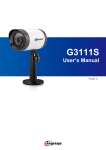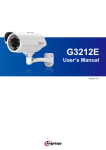Download MI AS-310-2013-6 - Management of Policy and Procedure Information
Transcript
Management Instruction Management of Policy and Procedure Information This management instruction provides guidelines for developing and distributing electronic and paper documents that contain policy and procedures (regulations, instructions, and implementation guidelines), and forms. These guidelines are critical to anyone involved in developing business policies, procedures, and forms. Policy Date June 26, 2013 Effective Immediately Number AS-310-2013-6 Obsoletes MI AS-310-96-3 Unit Brand and Policy Samuel P. Pulcrano Vice President Corporate Communications Document Management It is Postal Service policy to manage its paper and on-line documents so that they are correct, up to date, easy to find, and in agreement with official postal policies and procedures. Electronic and paper documents containing corporate policies, procedures, and forms (i.e., regulations, instructions, and/or implementation guidelines) must be published through Brand and Policy, Corporate Communications, and maintained as part of a corporate repository for tracking and easy access. Originating offices contact Brand and Policy to initiate the publication of new and revised documents and to obsolete documents when they become redundant or out of date. Brand and Policy stores documentation pertaining to clearance of a document, but it is the responsibility of the accountable originator to take necessary clearance steps. The approval of an accountable originator is sufficient to initiate publication and distribution. Vice presidents regulate within their own organizations which employees can approve different types of documents. Clearance Originating organizations either assume full accountability for documents containing policy and procedure or they share accountability with others who need to be involved for any reason: to add needed expertise; to help minimize potential negative legal, contractual, or other business consequences; and/or to sign when formal concurrence is necessary. Originators involve others early in the development process to make use of needed expertise and take steps necessary to manage legal, contractual, and business consequences. Others involved plan ahead to review necessary sections of the document within an agreed-upon time frame. Management Instruction AS-310-2013-6 CONTENTS Policy . . . . . . . . . . . . . . . . . . . . . . . . . . . 1 Document Management . . . . . . . . . . 1 Clearance . . . . . . . . . . . . . . . . . . . . . 1 Background . . . . . . . . . . . . . . . . . . . . . 2 What is document management? . . . 2 What documents need document management? . . . . . . . . . . . . . . . . . 2 What are the benefits of document management? . . . . . . . . . . . . . . . . . 3 Managing Consequences . . . . . . . . . . 3 What part does consequence management play in document management? . . . . . . . . . . . . . . . . . 3 Who should be included for consequence management? . . . . . . 3 Who should sign off? . . . . . . . . . . . . . 4 How can document management be provided for previously distributed documents? . . . . . . . . . . 4 Responsibilities . . . . . . . . . . . . . . . . . . 5 Document Development Procedures . . . . . . . . . . . . . . . . . . . . . 6 Early in the planning stage . . . . . . . . 6 During document development . . . . 11 When a stable draft is ready. . . . . . . 11 When the review period has elapsed. . . . . . . . . . . . . . . . . . . . . . 11 When the final copy is ready . . . . . . 12 When you are ready for paper publication and/or electronic distribution . . . . . . . . . . . . . . . . . . . 12 1 Originators use a clearance memorandum to: Approve documents themselves, List those who worked with them and then approve documents themselves, or Obtain signatures of accountable partners and then sign themselves — as appropriate, considering the nature of the information. Policy. A statement of corporate position or intent. Procedures. Actions to be taken, including regulations (required actions, often mandated by federal, state, or local laws), instructions (business practices, how-to’s), and guidelines (suggested ways of implementing business practices). Directive. A document containing policy or procedure information. Form. A document used for collecting, sorting, transmitting, and recording data. Background What is document management? Document management is the process for producing, clearing, storing, and tracking documents so that they are correct, up-to-date, easy to find, and in agreement with official Postal Service policy. What documents need document management? Within the Postal Service, document management is especially important for documents that contain policy information, procedure information (regulations, instructions, or guidelines), implementation information (information that helps to implement policy or procedure), and forms. Any document — for example, a handbook, a manual, a Postal Bulletin article, a memo, or form — containing these types of information is a candidate for document management. (See Table 1.) Table 1 Information Types Policy Description, Statement of Intent position, commitment Examples Regulation Instruction, business process Required action, consequences implied Normal action, how-to, what business plan calls for – USPS will.... – Employees must.... – USPS is committed to.... 2 Procedure Information Guideline Useful action, priorities, or options, discretion involved Announcement, notification, general information – To X, do a, b, – A manager may.... c.... – Mailers must.... – Use Form NNN to.... – Supervisors may not.... – The Postmaster gives.... Form – Do any of the following, as appropriate.... Postal Service forms — both printed and electronic — are used for collecting, sorting, transmitting, and recording data. PS Form 3849, Delivery – The new positions are.... Notice/Reminder/ Receipt – Flu shots will be given on.... – Options to consider are.... Management Instruction AS-310-2013-6 What are the benefits of document management? Document management ensures that information is: Accessible to those who need it. Accurate, consistent, and representative of the best practices. Revisable in a managed environment when those practices change. Auditable for legal and historical purposes. Managing Consequences Document management. A system for cataloging, storing, and making available for retrieval current and past corporate documents. Clearance. Agreement of those with vested interests. Consequence management. Anticipation and control, through careful review by qualified personnel, of all potential negative consequences that might result from written documents. What part does consequence management play in document management? Consequence management is a vital part of document management that minimizes the possibility of expensive or embarrassing consequences to the Postal Service that can result from written information. Consequence management is achieved by involving, from the outset, qualified personnel to help develop, review, and approve the information in a document, and by keeping informed all those who will be affected by it. Who should be included for consequence management? Consequence management minimizes the possibility of document consequences that are costly, embarrassing, or otherwise hazardous by making sure that the right expertise is used during document development and that those impacted are aware of what is being issued. The consequence management process starts when you assemble a development team. Your team’s role in the consequence management process is to help you frame specific issues during the drafting period; help you choose a clearance option; and then, if necessary, provide formal concurrence. Representatives from the following groups should be included in your development team and provide formal concurrence if your document touches on legal, financial, or labor relations issues. General Counsel. There are some general guidelines that will help you predict whether or not your document will need formal concurrence from General Counsel. First, if your document requires publication in the Federal Register, or is an update or revision to the Code of Federal Regulations, the Mailing Standards of the United States Postal Service, International Mail Manual (IMM), the Mailing Standards of the United States Postal Service, Domestic Mail Manual (DMM), or the Supplying Principles and Practices, you can probably assume that it will need to be signed off on by General Counsel. Second, if the subject matter of your document involves another federal agency or federal statutes; if it involves purchasing contracts, procurement acts, or labor and/or employment laws; if it touches on issues having to do with the mailing regulations, delivery and collection of mail, mail preparation or postage payment; then you will be wise to consider formal concurrence from General Counsel. Contact the General Counsel for assistance in finding a team member who can help you with legal consequence management. Management Instruction AS-310-2013-6 3 Labor Relations. Labor Relations can assist you in minimizing labor relations issues and problems when policies and procedures affect either bargaining unit or nonbargaining unit employees. In addition, Article 19 of the national labor agreements requires that unions be notified of changes in Postal Service documents that directly relate to wages, hours, or working conditions, and the Postal Reorganization Act requires that management associations be consulted about changes related to pay or other issues affecting nonbargaining unit employees represented by the management associations. If there is any reason to believe that your document deals with information that touches on any of these issues, ask for a Labor Relations contact and consult with him or her early in the process. Only Labor Relations can determine whether notification to the unions is contractually required or consultation with management associations is necessary. Inspection Service. To predict whether your document will need Inspection Service consequence management, consider whether it deals with issues which fall within the Inspection Service’s area of responsibility. If your document pertains to issues related to employee security and safety, security of Postal Service facilities, both owned and leased, alarm systems, identification cards and credentials, security of other Postal Service assets, and security clearances for Postal employees and contractors, you will want to ask the Inspection Service for formal concurrence. Who should sign off? Whether or not an originator has authority to sign off on a given document is determined by the policy established within his or her functional organization. Authority determination may be based on factors pertinent to the organizations. Suggestions include: Type of information (for example, policy and regulation vs. business process, guideline, or information). Type of document (for example, policy manual or procedure handbook vs. Postal Bulletin article with a simple announcement or clarification). Case-by-case determination. How can document management be provided for previously distributed documents? If you believe that a previously distributed document does in fact contain policy, procedure, or implementation information that should have gone through the document management process, but did not, you should clear the document using the appropriate level of clearance. 4 Management Instruction AS-310-2013-6 Responsibilities Vice presidents and managers are responsible for: Understanding the clearance and document management processes. Promoting an environment of collaboration. Using and supporting the use of the process. Establishing a delegation policy for their functional organizations. Seeing that documents are obsoleted when they become redundant or out of date. Originators are responsible for: Understanding processes. Determining: the clearance and document management The type of information to be conveyed (policy, instruction, regulation, guideline, implementation information, or form). The best type of document to use for conveying that information. The clearance requirements of the document, based on an assessment of its contents. The document management requirements of the document, based on an assessment of the future need to access its contents. Choosing one of the three clearance options. Involving others as needed in developing the document. Carrying out the clearance steps as identified. Arranging for final review and sign-off. Ensuring that each reviewer understands what the changes to the document are and why. Distributing copies before publication to those who will be affected by the document and to Labor Relations for notice to the employee organizations if needed. Effecting closure of the process. Being timely throughout. Others involved are responsible for: Understanding processes. Providing the needed expertise during document development. Helping determine the nature of any review ultimately necessary and establishing a realistic time frame. Being timely in contributions and, if formal concurrence is required, review and sign-off. the clearance and document management Brand and Policy is responsible for: Providing consultative editorial and publishing support. Assisting in the publication of documents after a signed clearance memorandum has been received. Organizing and providing document management, including cataloging, storing, accessing, sunsetting, and archiving the document and archiving the clearance documentation. Management Instruction AS-310-2013-6 5 Document Development Procedures Following these document-development procedures will help you clear your document in the easiest way appropriate to your material and initiate management of your document within the corporate document management system. Originator. The author of a document who is responsible and accountable for seeing it through the document management process, including arranging for any type of clearance required. Development team. Staff who agree to help and advise an originator with the content of a developing document and to arrange for and provide the level of clearance that the document requires. Production team. Staff who agree to advise and help an originator with the writing, editing, production, publication, and distribution of a document. Early in the planning stage 1. Announce your project. Once you have determined that there is a need for your document, let others know about it as appropriate, both to inform them and to allow them to assist you throughout the development process. 2. Plan your project. A. Verify that funding is available by checking with your department’s budget coordinator. B. Choose a document type. (See Table 2.) Focusing on the information need — what type of information you want to convey, who uses the information, how it is used, how it might best be structured and presented — helps you decide on what type of document to use. Other factors to consider are the length of the material, how soon it may change, and the urgency for distributing it. Table 2 Document Types Type of Document Description Distribution Drafts for the Code of Federal Regulations or the Federal Register Contain federal statutes, including those that define the Postal Service’s mandate and responsibilities and its ability to establish policy and regulations. N/A Manuals Contain the basic policy information for the Postal Service. Various websites including PolicyNet Web site. DMM Mailing Standards of the United States Postal Service, Domestic Mail Manual Regulations and information about domestic mail services. PolicyNet Web site, Postal Explorer Web site, and about.usps.com Web site. IMM Mailing Standards of the United States Postal Service, International Mail Manual Regulations and information about international mail services. PolicyNet Web site, Postal Explorer Web site, and about.usps.com Web site. POM Postal Operations Manual Policies for operation of Post Offices and for mail processing, transportation, and delivery. PolicyNet Web site ASM Administrative Support Manual Policies for USPS administrative and support functions. PolicyNet Web site and about.usps.com Web site. ELM Employee and Labor Relations Manual Personnel policies and regulations governing USPS employment. PolicyNet Web site and about.usps.com Web site. Operating procedures, usually including instructions. Generally contain more procedural than policy information. PolicyNet Web site, some handbooks are posted on about.usps.com, and some are stocked in the Material Distribution Center (MDC). Handbooks 6 Management Instruction AS-310-2013-6 Table 2 Document Types Type of Document Description Distribution Publications Appear in a variety of formats such as books, brochures, reports, etc. Generally do not focus on policy as extensively as manuals; nor on task descriptions as extensively as handbooks. Often contain material intended primarily for the public, such as mailing guidelines or marketing information. PolicyNet Web site, some publications are posted on about.usps.com, and some are stocked in the MDC. Management Instructions Short, permanent instructions for specific employee groups. Contain material too specialized, technical, volatile, or otherwise unsuitable for manuals or handbooks. PolicyNet Web site Policy Memos Memos for quickly distributing, to a target audience, policy information that may later appear in a more permanent form. Can be written with the use of an electronically stored template. PolicyNet Web site Posters Often (though not always) contain policy information that for any reason requires public display. Some are posted on the PolicyNet Web site, some are distributed in print, and some are stocked in the MDC. Labels, Signs, Tags, and Kits Brief instructions, information, identification, promotional material, safety and energy messages. Some are posted on the PolicyNet Web site, some are distributed in print, and some are stocked in the MDC. Postal Bulletin Published biweekly. Used for temporary and emergency instructions and fast issuance of permanent instructions before printing in permanent directives. Distributed in limited quantities in print; posted on the PolicyNet Web site, and the about.usps.com Web site. C. Contact Brand and Policy to plan for the delivery of editorial, graphic, and composition services for your document. Brand and Policy will provide the following as necessary: Guidance on graphic and electronic standards. Help with information design so that your document can be easily read and understood. The official identification number (once a clearance has been received). Information necessary to establish a production schedule. If you are planning a Postal Bulletin article, contact the Postal Bulletin editor within Brand and Policy for a schedule of publication and deadlines and any special instructions you will need. Note: Brand and Policy will start the actual work to produce a document only if it receives a signed clearance memorandum. Management Instruction AS-310-2013-6 7 D. Identify and assemble a development team of those whom you need to assist you. Once assembled, your team members can, if necessary, help determine the nature and scope of their involvement, develop a schedule, and establish whether formal concurrence will be required. Your development team should include: E. Any others with whom you share authority with regard to the document information. (Both Human Resources and Finance, for example, may share authority for a document on pay.) Any others needed to provide guidance in managing potential consequences, especially General Counsel, the Inspection Service, or Labor Relations. (See Who should be included for consequence management?) Any others with a substantive interest or significant expertise. Any others from whom a sign-off may later be required. If you do not know who is the correct contact within a functional organization, Brand and Policy can help you identify the right person. Decide on an appropriate clearance process, considering who has authority for the document; who needs to assist you; whether there are labor relations, legal, or audit issues that require the involvement of General Counsel, Labor Relations, or the Inspection Service; and whether formal written concurrence is required to document the involvement of others. (See Table 3.) Table 3 Options for Clearance If... Then... Option 1. You are solely accountable and there are no legal or labor relations consequences to be managed, Sign off on the Option 1 clearance record memo or the policy memo yourself. Option 2. You partner with others in document development and there are no legal or labor relations consequences to be managed, List team members and sign off on the Option 2 clearance record memo yourself. Option 3. You want formal concurrence from team participants or there are legal or labor relations consequences to be managed, Get signatures from representatives of other accountable organizations and sign off on the Option 3 clearance record memo yourself. Note: Delegation of authority to sign off on documents is a matter for vice presidents to handle within their own organizations. (For guidance in this matter, see Managing Consequences, Who should sign off?) 8 Management Instruction AS-310-2013-6 Examples You might use Clearance Option 1 (sign yourself), for example, if you are a vice president issuing a policy statement by policy memo or a staff person delegated to issue a clarifying announcement in a Postal Bulletin article. You might use Clearance Option 2 (list those involved and sign) if you need input but not approval, if you are the originator of a user manual or implementation guidelines, or if you are reissuing previously cleared information with no substantive changes. You should use Clearance Option 3 (get formal concurring signatures and sign) when: There may be legal consequences, so concurrence by the General Counsel is required. There may be an impact on wages, hours, or working conditions of bargaining unit employees, or on pay or other issues affecting nonbargaining unit employees represented by the management associations, so concurrence by Labor Relations and union notice and/or management association consultation are required. There may be an impact on security or law enforcement procedures, so concurrence by the Inspection Service is required. There is another functional organization sharing authority for the document content, so concurrence by that organization is required. You may also use Option 3 when, for any reason, you want to maintain a formal clearance trail. (For more information about using Option 3, (See Who should be included for consequence management? and Who should sign off?) To access the clearance documents go to http://blue.usps.gov/cpim/ clearance/clearance.htm. See Exhibit 1. Management Instruction AS-310-2013-6 9 Exhibit 1 Clearance Documents 10 Management Instruction AS-310-2013-6 During document development… 3. Involve the others you have identified to help you and use their expertise. Work with your development team. Some members may need to work with you throughout development, helping you write and structure the information. Others may assist with consequence management by framing problematic sections or doing a formative review of certain issues. Work with your production team to obtain the editorial, graphic, and composition services agreed upon during the planning stage. 4. Plan for formal concurrence. If you have determined that you will need formal concurrence (Clearance Option 3), agree with those involved on what sections they will need to cover and how much time they will need for review. Formal concurrence. Official signatures on an Option 3 clearance record memo by qualified personnel indicating their involvement during a document’s development and their approval of the final draft. When a stable draft is ready... 5. Provide copies of the document for review. If you have decided you will need formal concurrence, give each member of your development team (and any others from whom you want formal concurrence) a copy of the draft and a clearance review and signature request memo identifying what is needed from each of them and noting the agreed-upon time frame for review. (See Attachment D for a sample.) If the document is a revision of an existing document, add a summary of changes. Send the draft (along with the summary of changes if your document is a revision) and the memo by email so that the reviewer may choose whether to print it out and mark it or work electronically to mark requested changes using the revision feature of Microsoft Word. The reviewer should call to negotiate an extension if he or she cannot return the document within the established time frame. 6. Provide a copy of the proposed document to Labor Relations for review. Labor Relations will provide guidance on its process to clear the document. When the review period has elapsed... 7. Integrate changes. Negotiate to resolve remaining differences with reviewers and integrate changes to prepare a final draft. 8. Be accountable for conflict resolution. Determine with management consultation whether you can assume accountability for overriding any changes considered mandatory by reviewers. If necessary, prepare a summary of unresolved issues for your vice president. If reviews are not returned, contact the reviewer, determining with management consultation whether you can assume accountability for bypassing further consultation. Management Instruction AS-310-2013-6 Consultation copies. Advance copies of a draft document provided to management associations for the purpose of consultation pursuant to Title 39, Section 1004. Information copies. Final copies of a document provided as a courtesy to those with a right to know or vested interest in its content. Notification copies. Final copies of a document provided to labor unions for the purpose of official notification pursuant to the various collective bargaining agreements. 11 9. Complete the final copy. Have editorial, graphic, and composition work completed and final copy prepared. When the final copy is ready... 10. Provide information and notification copies. Provide copies as follows: To Labor Relations if the necessity for union notice and/or management association consultation was established during earlier team work or at the time of review. To the Inspection Service Office of Counsel if a copy was not provided previously for their formal concurrence on issues affecting security or law enforcement responsibilities. To the Chief Operating Officer if the document deals with operational issues. To other functional and area vice presidents not involved in the development process who may be affected. To your team members. When you are ready for paper publication and/or electronic distribution... 11. Brand and Policy Role in Document Production You must also provide the clearance document signed by the appropriate manager that registers your accountability. (See Attachment A, Attachment B, and Attachment C for samples taken from the Clearance Options 1, 2, or 3.) If you have asked for formal concurrence by using Clearance Option 3, you must also provide electronic copies of the marked review copies and signed clearance review and signature request memos to document your clearance trail. Note that Brand and Policy will accept the signature of an accountable originator as evidence that all necessary clearance steps have been taken and will produce and distribute the document solely on that basis. As the accountable originator, however, you will want to ensure that any official clearance documentation is saved and available for review, so make sure you submit any such documentation along with your document. Brand and Policy will either produce the document or assist in its production. If you have had production work done by a vendor, you must provide these electronic files to Brand and Policy. 12 Management Instruction AS-310-2013-6 Attachment A Clearance Option 1 Management Instruction AS-310-2013-6 13 Attachment B Clearance Option 2 14 Management Instruction AS-310-2013-6 Attachment C Clearance Option 3 Management Instruction AS-310-2013-6 15 Attachment D Clearance Review and Signature Request 16 Management Instruction AS-310-2013-6

















